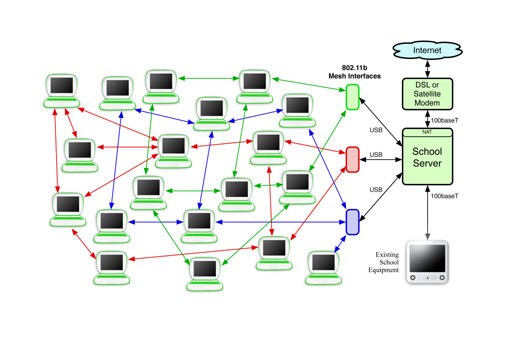Trial1 Server Software
This page describes the software for a quick first prototype of the School server, intended for use in trials of the XO laptop using Trial1 Software. This is not necessarily representative of the system OLPC plans to ship in production, it contains many simplifications to speed prototyping.
Contents
Target Platform
The target platforms for this software are:
- An XO laptop (AMD i586)
- A conventional desktop machine (Intel or AMD i586)
- XSX, a dozen early prototypes (hardware selection ongoing, i586)
At least 128 MB of memory (and a storage device capable of supporting virtual memory) is required.
The storage device may be attached using:
- SATA
- IDE (PATA)
- USB
The networking interfaces will be varied. Each server will support up to three Marvell wireless mesh networking modules connected via USB 2.0. In addition, at least two 100baseT network intefaces will be provided for connection to the WAN and LAN. These may also be connected via USB.
No graphics capabilities are planned. If a server (such as a desktop machine) has an attached keyboard and display, they will used for a text console.
Installation
It has been suggested that Pilgrim be used for building bootable images of the server software.
Disk Partitions
The OS and applications should have the root partition, initialized by the disk image. Optimum size TBD, 5GB for now. /dev is provided by udev, /proc and /sys by the kernel.
A logical volume manager will be used to manage the storage used by students and library content. One logical volume will be used, which will use a second partition on the disk.
Memory swap space will require one 2GB partition
Can Pilgrim handle a separate /var partition ? (1GB for now)
Manifest
This is the software manifest for the school server.
OS
The software will be based on Fedora Core 6. Where no explicit version information is provided for software, the version included in FC6 should be assumed.
We will be running a recent kernel (currently 2.6.20.), capable of booting on both the laptop and a more conventional desktop machine.
Interpreters
Perl
Python
Python 2.4 for now. When the laptop transitions to 2.5 (before release in September ?), the server will as well.
Database Servers
MySQL
MySQL will be provided for use by local services. Access will be limited to localhost.
SQLite
SQLite 3 will be provided.
Web Server
Apache 2 will be provided.
Installed modules will include:
- mod_perl
- mod_php
- mod_include
Moodle
Moodle will provide tools for teachers.
Martin Langhoff will help with this once we have an image ?
Moodle may provide a solution for some of the school administration tasks as well.
MediaWiki
MediaWiki will be installed on the server, and made available at: http://schoolserver/wiki/
Content (SJ) will provide default content. How is this packaged and installed ?
MoinMoin
MoinMoin will be installed on the server.
Networking
 Trial1 School Network
(printable version)
Trial1 School Network
(printable version)
A single school server will be deployed in these initial installations, simplifying the network. Between two and three wireless mesh network interfaces will be deployed, attached to the school server via USB. Two wired networking interfaces will also be provided, for connection to the Internet via a WiFi interface or DSL, satellite, or 2.5G/3G modem.
Filtering & Masquerading
Network Address Translation (NAT) and Port Address Translation will be provided on the network interface connecting to the Internet. These mechanisms allow all of the laptops in the school to share a single IP address This is provided by the iptables mechanism in the Linux kernel, but the configuration mechanism is still unclear.
The only other packet filtering done by the school server is a transparent proxy for packets exiting the server addressed to port 80. These are redirected to the school server's port 3128, where the Squid HTTP cache will be listening.
Routing
The server will be tasked with routing between the different network segments attached to it. These include:
- Between one and three mesh network segments
- A wired network segment, which may include standalone APs.
- An optional wireless segment using the server as the AP ?
Bridging vs. Routing
While there is a temptation to declare the individual network segments part of the same subnet and bridge between them, it was instead decided to declare them individual subnets and route between them. The main outcome of this being that broadcast and multicast packets will not be relayed between wireless mesh segments. In cases where it is determined that this poses a problem, we may explicitly route some multicast packets between mesh segments.
DHCP
DHCPD will be provided on all network segments except the one connected to the WAN.
Devices on the 'internal' network will be assigned non-routable IP addresses, in the 10.0.x.x range.
DNS
A local DNS server will be provided to cache common requests, in order to provide better network performance. It may also be used to provide a DNS entry for each laptop, using a DHCP-DNS connection script, or explicit DHCP/DNS server integration.
HTTP Cache
Squid 2.6 will be used for now.
Maintenance & Utility
The following services will be provided:
sshd
Used both for maintenance and as the transport for backups from the laptops.
rsync
Provided as a command line tool, not run as a daemon. Used for backups.
Updating
The School server software will be updated from an OLPC maintained repository, using yum, the package manager in Fedora. While this repository will probably be country/region specific, it currently resides in Cambridge, US.
An software update will be periodically triggered on the school server. Probably weekly ?
Laptop updates use a separate mechanism, which relies on the school server to provide the update files.
Monitoring
A method for monitoring the health of school servers deployed in the field is still under investigation.